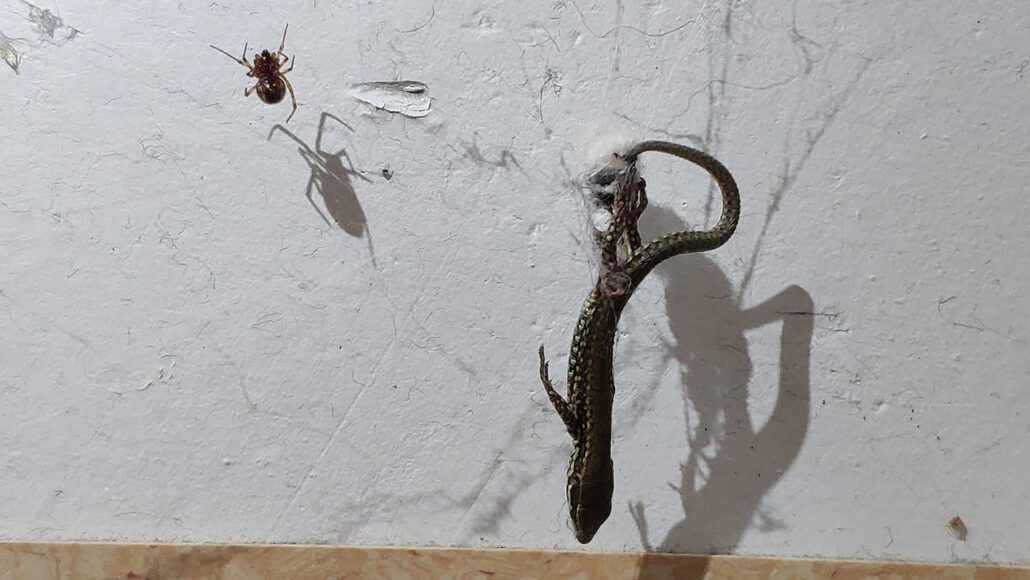Tiny spider uses silk to lift prey 50 times its own weight
Spinning the right lines can accomplish incredible feats of strength

A small Steatoda spider uses its own version of a pulleylike system, created by adding repeated silk threads. This can haul heavy loads upward bit by bit, such as this lizard.
Emanuele Olivetti
By Susan Milius
One family of spiders can catch prey many times their own weight by hitching silk lines to their quarry and hoisting the meaty prize up into the air.
These tangle web spiders are masters of using silk to amplify muscle power. Their webs are “a messy tangle,” says Gabriele Greco. He studies biological materials at the University of Trento in Italy. Silk strands in the web crisscross in a cobwebby scribble.
Greco and Trento coauthor Nicola Pugno filmed how spiders hunt from such snarls. The pair focused on big catches: insects weighing up to 50 times as much as the spiders themselves. The web makers, however, could win their battles. That’s thanks to skillful fighting, venom and lots of prey-wrapping silk. Victorious spiders also attached multiple silk threads to their prey bundle to haul the feast up to the web. Yet oddly, these threads never got pulled totally taut.
Greco and Pugno described all this February 3 in Journal of the Royal Society Interface.
To analyze the spiders’ weight-hauling moves, the researchers set up lab boxes. The boxes had black walls for easy observation of white silk. Inside each box went one of these spiders from a Theridiidae species. Some were triangulate cobweb spiders (Steatoda triangulosa). Others were false black widows (S. paykulliana).
In the wild, both species stretch some strands from the tangle down to the ground. There, a sticky end anchors the strand. When some small, edible creature such as an ant bumbles against the strand, it breaks loose from the ground. The strand then yanks the tiny morsel upward to flail in the air.
Lunch!

Educators and Parents, Sign Up for The Cheat Sheet
Weekly updates to help you use Science News Explores in the learning environment
Thank you for signing up!
There was a problem signing you up.
What really interested Greco and Pugno, however, were reports of these strands occasionally catching “giant” prey. These included critters as big as a snake or a mouse. To give the food-catching silk a good workout, researchers used big cockroaches.
A single sticky-end strand can’t jerk a heavy roach into the air. So when this prey bumps the silk, the resident spider rushes to add extra strands. In the lab tests, spiders had to add strand after strand before researchers saw the first upward lurch. During the whole raising process, the hauling threads still maintained some give instead of being stretched very tight. That makes sense, Greco concluded. That’s because these strands get tugged and jounced a lot by struggling prey. Super tight strands might break.
What these spiders have evolved isn’t a loading-dock pulley with a wheel. Instead, they attach a lot of silk strands to a load. This gives the tiny animals their own way of lifting heavy burdens a little bit at a time. After some 400 million years of evolution, spiders’ forms and uses of silk fascinate researchers like Greco, who are looking for new materials.
The new study of silk-based weight-lifting strikes Symone Alexander as “very cool.” She’s a chemical engineer at Auburn University in Alabama. The most popular notion of spider silk envisions rounded, spoked webs on Halloween décor. However, spiders have expanded the places and ways they can live with a wide range of silky innovations. They have evolved silky trap doors, nets, lassos and — one Alexander studied — ultrafast slingshots.
“Even in a single web, there are different types of silk (and glue) used to make frame lines, capture lines and anchor lines,” she says. “Spiders are ingenious.”